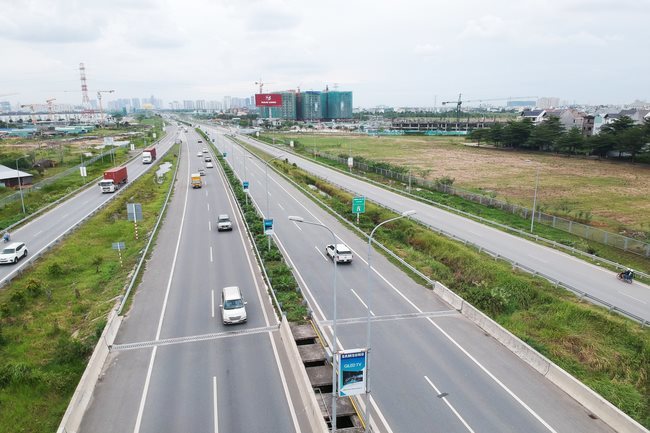 |
| Realty inventories are rising |
While inventories are hardly surprising, it remains to be seen how firms will deal with huge debt and rising inventories.
In a recent report to the National Assembly, the State Bank of Vietnam (SBV) unveiled some data on credit. In 2018, it rose by 13.89% against the figure in late 2017. The amount as of April 29, 2019 was 4.44% higher than at the end of 2018.
The credit profile has undergone encouraging changes, with focus on manufacturing and other high-priority sectors. In particular, agriculture and rural areas account for the highest ratio (25.1%), followed by consumption (19.66%), realty (for both business and personal use) (18.08%), as well as small and medium enterprises (18%).
It is worth noting that the share of realty loans has surged. Almost one year ago, at the end of June 2018, realty loans claimed about 7.5%. Subsequent research mostly estimates the share of realty loans at 10%, peaking at 13-14% (including those masquerading as consumption loans).
However, the figure has jumped to 18%, equivalent to VND1,300 trillion. Due to the lack of data, the writer is unsure if this is due to changes in categorization or a dramatic increase in realty loans.
In response, the SBV has tightened credit. The share of short-term capital used for medium- and long-term loans has decreased from 45% to 40% (and may fall to 30%). The central bank has also announced a circular to amend Circular 36 with changes to the risk coefficients associated with realty loans.
For personal loans of VND3 billion and above, the amount set aside as a buffer against risks is 150%. It is believed that this move will indirectly restrict capital flows into the realty sector, especially personal loans for high-end apartment purchase.
Rising risks
The rising share of realty loans is reflected in the expanding debt of listed realty firms. By the end of the first quarter of 2019, 10 big listed realty firms—VIC, NVL, FLC, VCG, DXG, CEO, KDH, TDH, PDR and HQC—had total liabilities of VND317 trillion, of which bank loans by March 2019 surpassed VND134 trillion, equivalent to US$5.83 billion.
Vingroup incurs the most short- and long-term debt, domestic or otherwise (VND92 trillion). Novaland ranks second (VND26 trillion by the end of the first quarter of 2019), mainly loans extended by VietinBank, VPBank, Vietcombank, Sacombank and KienlongBank.
This trend has become riskier since the SBV plans to tighten credit and various economic challenges have arisen, hampering demand for realty products. A warning sign pertains to soaring inventories.
According to a report by the HCMC Real Estate Association (HoREA ) on December 21, 2018, the inventories of the 65 listed realty firms amounted to about VND202 trillion, more than double that of 2013, when the market freeze was the most severe.
Financial reports by the 10 listed realty firms indicate that their inventories at the end of the first quarter of 2019 hovered around VND108 trillion, up about 50% of the inventories of 65 firms compiled by HoREA in late 2018. Vingroup recorded the highest figure (almost VND50 trillion), followed by Novaland (VND35.7 trillion) and Khang Dien (VND5.5 trillion).
In reality, the realty sector is characterized by a long investment cycle that spans many years, with products sold over different phases and projects overlapping. Inventories that rise as a company develops are therefore hardly surprising. However, it remains to be seen how firms will deal with huge debt and rising inventories when faced with a demand shock.
Slower growth will drag down income while speculative demand may be impeded by restricted access to bank loans. Sales will drop, money flows are harder to balance, and firms’ debt repayment capabilities will be suspect.
However, statistics show that the situation has yet to spiral out of control. By late 2018, 23 joint stock commercial banks had VND5,700 trillion worth of realty-related collateral, accounting for 57.4% of the total assets used as collateral.
This was book value only and may not fully reflect the true value of the assets. This figure is rather safe since banks can sell such assets to offset any bad debt that arises. With risks rising and warning signals emerging, the authorities and players in the realty market (both investors and house buyers) must approach their tasks with discernment. SGT
Linh Trang

Tightening credit for luxury home purchases might rock realty market: experts
If credit policies for luxury home puchases were tightened, it could be a shock for the property market, experts have warned.

Slowing realty growth in Vietnam due to dependence on credit: experts
The local real estate market has shown signs of deceleration so far this year, partly because of limited bank credit for the market, according to experts.
Vietnamese firm introduces AI-powered realty forecast technology in Japan
The Vietnamese-based Vitalify Asia Co., Ltd. has unveiled its robotic process automation system specialising in making real estate predictions.
 Realty credit has soared compared with that of last year. Realty inventories have piled up, signaling rising risks. " itemprop="description" />
Realty credit has soared compared with that of last year. Realty inventories have piled up, signaling rising risks. " itemprop="description" />